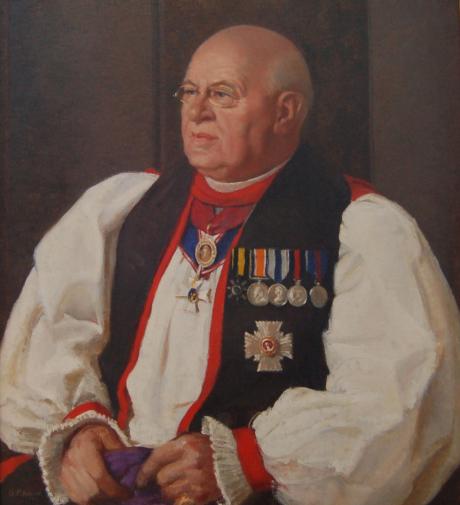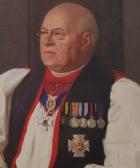signed and inscribed " A H Neave / 1931"
Robert Freres and Salon, Paris 1935
Smith, John Taylor (1860–1938), bishop of Sierra Leone and chaplain-general to the forces, was born on 20 April 1860 at Kendal, Westmorland, the second son of James Smith, coal agent, and his wife, Jane. He had two brothers and two sisters. He was educated at Kendal grammar school. When aged twelve Taylor Smith experienced an evangelical conversion, which left upon him a deep and permanent impression. He was actively involved in evangelistic activities from his youth and there are indications that he felt early the call to full-time Christian ministry. Nevertheless he dutifully acceded to his father's desire that he enter a trade through his brother's jewellery business. Taylor Smith finally gave up watch making in 1882. The story of his final call to the ministry characterizes Taylor Smith's brand of evangelical religion: providence specially guided him to Carlisle Cathedral, where God spoke through the Old Testament lesson. Taylor Smith trained at the strongly evangelical London College of Divinity at St John's Hall, Highbury (1882–5). He was a poor student academically, but impressed with his ebullient personality and his zeal on college missions. In 1885 he accepted a curacy at St Paul's, Upper Norwood. His vicar, the Revd W. H. Graham, was frequently ill, allowing Taylor Smith ample opportunity to develop. It was at Upper Norwood that his skill as a popular, colourful preacher first blossomed.
In 1889–90 Taylor Smith felt the call to missionary work overseas. He turned down the chance to go to Uganda, but subsequently accepted an invitation to serve with the Church Missionary Society in Sierra Leone. He left England in February 1891, and from 1891 until 1897 was subdean and canon of St George's Cathedral, Freetown; he was also diocesan missioner. The climate took its toll and he suffered severe bouts of fever. Nevertheless he worked hard and was remarkably successful, not least in persuading African Christians to volunteer for missionary work. Unexpectedly Taylor Smith served as chaplain to the Asante expeditionary force in 1895, and this was undoubtedly the turning point of his career. Prince Henry of Battenberg fell seriously ill and left a message with the chaplain for his wife. When the prince died on 21 January 1896 Taylor Smith travelled to Europe to deliver the message in person. He made a favourable impression not only on Princess Beatrice but also on Queen Victoria: he was subsequently created honorary chaplain to the queen. It was no surprise, therefore, when Archbishop Temple made him the new bishop of Sierra Leone in 1897. The main achievement of Taylor Smith's episcopate lay in the creation of a cathedral chapter. He kept up a hectic round of engagements and suffered further life-threatening attacks of fever. Thus, when the War Office offered Taylor Smith the post of chaplain-general, friends urged him to accept. At first inclined to refuse, he accepted when he felt ‘the Pillar of Cloud’ (that is, God) was leading him to a fresh pilgrimage. He was appointed on 1 November 1901. The choice caused great surprise at the time, but may be attributed to two factors: the Church of England was determined to have a bishop as chaplain-general and a group of senior army officers pressed for Taylor Smith's appointment. He was at the War Office for almost twenty-four years. This long period as chaplain-general can be divided into two distinct, though unequal, parts. In peacetime Taylor Smith was successful: he concentrated especially on preaching and mission work in the army, for which he had particular talents, and was unquestionably popular with the regular army.
It is his role as chaplain-general during the First World War which occasions great controversy. Alan Wilkinson marshalled evidence to adjudge Taylor Smith naïve, inefficient, and bigoted. But those contemporaries who testified to this effect, in particular Anglo-Catholics and sophisticated intellectuals, were themselves partial. The truth is that the scale of the challenge which Taylor Smith faced would probably have overwhelmed most men. As it was, he quickly learned to delegate. On 16 July 1915 Bishop Llewellyn Gwynne was appointed deputy chaplain-general with special responsibility for chaplains and troops in France, while Taylor Smith concentrated on administration from London. His success can be measured by the continual supply of sufficient chaplains throughout the war and by his calm resistance to self-interested calls for change and innovation. The First World War aged Taylor Smith greatly. Nevertheless he oversaw a comprehensive reorganization of his department in 1920, which brought about a unified system of administration for all denominations except Roman Catholics, and which brought in Territorial Army chaplains with the regulars. After his return from Africa in 1901 Taylor Smith involved himself wholeheartedly in the work of numerous evangelical societies. His interest in young people's activities led to involvement in camps for public schoolboys, the Boys' Brigade, and the Children's Special Service Mission. Work for the Alliance of Honour was in line with his desire as chaplain-general to encourage young soldiers to abstain from sex outside marriage. Taylor Smith was also active in the Scripture Gift Mission, the Scripture Union, and the Evangelical Alliance. He spoke regularly at Keswick. Taylor Smith retired in April 1925. From then until his death he led a frenetic lifestyle, being in constant demand as a preacher and missioner. He travelled all over the world, and it was while returning from Australia on board the SS Orion that he died on 28 March 1938 and was buried at sea. He had never married. Taylor Smith was a big, burly man with a powerful preaching voice. His sermons were liberally embellished with stories and anecdotes. He was not widely read and his intellect was limited, but he did have the common touch. His autograph book entries, for example, were homely and comforting, and prized by their recipients for their consolatory messages. Public honours did come in his lifetime (he was made a CVO in 1906, a CB in 1921, and a KCB in 1925) and his achievements were certainly more substantial than has generally been allowed.
I. T. Foster DNB
Painter, born at Hastings, Sussex. The daughter of Dr Arthur Henry Headley Huckle, Alice was born on 6th October 1903 in Hastings. She appears to have inherited her grandfather’s artistic interests. She trained at the Slade School of Fine Art, studying with Sir Walter Restley Russell and Henry Tonks. She was apparently awarded the Landseer Prize in 1920, although this has not been verified. She married Alfred Neave in Rye in 1932 and they had three children. She died in 1977. There are some of her pictures in Hastings Museum and Art Gallery. She painted local scenes, usually in oil on board. She is noted as a prolific exhibitor. In the 1960s HMAG acquired pictures from single artist shows including Alice Headley Neave’s Children Returning to School. She attended the Slade School of Fine Art where she studied under Tonks and was awarded winning the Landseer Prize in 1920. Examples of her painting in HastingsMuseum and ArtGallery and the LetchworthMuseum and ArtGallery . she exhibited prolifically at the RA, NEAC, WIAC, RP, RBA RSA and the Paris Salon



